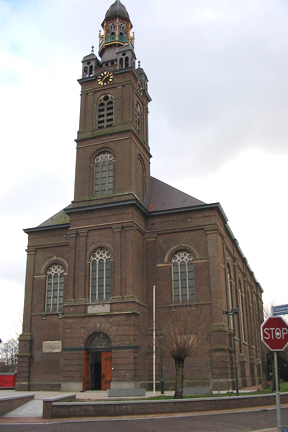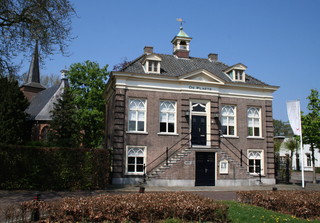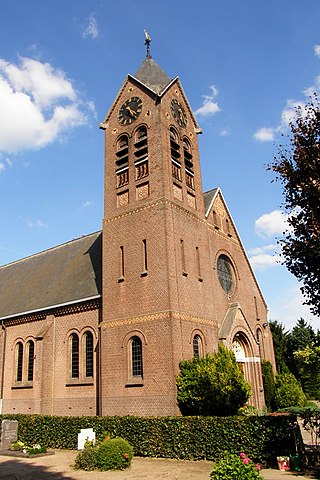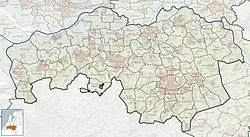
North Brabant, also unofficially called Brabant, is a province in the south of the Netherlands. It borders the provinces of South Holland and Gelderland to the north, Limburg to the east, Zeeland to the west, and the Flemish provinces of Antwerp and Limburg to the south. The northern border follows the Meuse westward to its mouth in the Hollands Diep strait, part of the Rhine–Meuse–Scheldt delta. North Brabant had a population of about 2,626,000 as of January 2023. Major cities in North Brabant are Eindhoven, Tilburg, Breda, its provincial capital 's-Hertogenbosch, and Helmond

Veghel is a town and a former municipality in the Southern Netherlands. On 1 January 2017 Veghel, together with Schijndel and Sint-Oedenrode, merged into a new municipality called Meierijstad creating the largest municipality of the province of North Brabant in terms of land area.

The Meierij van 's-Hertogenbosch was one of the four parts of the Duchy of Brabant, the others being the Margraviate of Antwerp, the County of Brussels and the County of Leuven/Louvain. Located in the current-day Netherlands, it acquired its name from the bailiff of 's-Hertogenbosch, who administered the area in the name of the Dukes of Brabant. The Meierij roughly corresponds to the larger province of North Brabant.

The Zuid-Willemsvaart is a canal in the south of the Netherlands and the east of Belgium.

Bernheze is a municipality in the southern Netherlands, in the province of North Brabant. It was formed as a rename of Heesch in 1995. The municipalities of Heeswijk-Dinther and Nistelrode had merged into Heesch in 1994.

Sint-Oedenrode is a town in the province of North Brabant.

Heeswijk is a Dutch village. It is located in the province of North Brabant, in the south of the Netherlands.

Erp is a village in the southern Netherlands, in the province of North Brabant between 's-Hertogenbosch and Eindhoven. Prior to 1994, Erp was a municipality consisting of the town of Erp and the villages of Boerdonk and Keldonk. In that year, the municipality was merged with the municipality of Veghel to form one municipality under the latter name. The area of the former municipality of Erp has a population of 6,663, while Veghel has a population of 37,655.

The Aa is a small river in the Netherlands. It rises near Nederweert in the southeastern province of Limburg, in the Peel region. It flows northwest through the province of North Brabant towards 's-Hertogenbosch, roughly along the Zuid-Willemsvaart canal. In 's-Hertogenbosch, at the confluence of the Aa and the Dommel, the river Dieze is formed, which flows into the Meuse a few km further. The main cities and towns along the Aa's course are Asten, Helmond, Veghel and 's-Hertogenbosch.

Heesch is a village in the Dutch province of North Brabant. Heesch is next to the village Vinkel. It is located in the municipality of Bernheze, about 3 km south of Oss.

Heeswijk Castle is a moated castle near Heeswijk in the Dutch province of North Brabant.

Berlicum is a town in the south of the Netherlands, located in North Brabant's Meierij region near the city of 's-Hertogenbosch and the river Aa. The town was most likely founded between 600 and 700 AD. It was a municipality along with the village of Middelrode until a large-scale municipal reorganisation in 1996, when Berlicum and neighbouring Den Dungen merged with the municipality of Sint-Michielsgestel. In 2009, Berlicum had 9,743 inhabitants.

Berne Abbey, a Dutch abbey of the Premonstratensians, or Norbertines, in Heeswijk, North Brabant, is a religious community in the Netherlands. It has 27 brothers and priests.

Loosbroek is a village and parish in the southern Netherlands. It is located in the municipality Bernheze, North Brabant.

Nijnsel is a village in the province of North Brabant, located in the Meierij of 's-Hertogenbosch. Nijnsel is a parish of the municipality of Meierijstad.

Sint-Oedenrode is a moderately urbanized city and capital of the former municipality of the same name in the province of North Brabant. The city is located in the Meierij of 's-Hertogenbosch. Sint-Oedenrode counts 17,928 inhabitants and has an area of 64.25 km². The municipality has traditionally city rights since 1232, and was known as a "Vlek" in the past. Today it is still a large town. From southeast to northwest, the city is split by the river the Dommel.

Oud Herlaer was a castle on the Dommel just east of Vught. All that remains is a farm which incorporates parts of the old castle. While not that much remains of the castle, there are a lot of recent studies about Oud Herlaer and its owners. The farm is planned to be opened as an art center in 2021. The name Oud Herlaer,, signifies that later on Nieuw-Herlaer Castle was built about 1 kilometer upstream.

Empel en Meerwijk Castle was a medieval castle just north of 's-Hertogenbosch. All that's left is a terrain where the castle outlines have been visualized.

Andreas Johannes Ludovicus baron van den Bogaerde van Terbrugge was a Dutch nobleman, politician, author and art collector. He served as Governor of North Brabant between 1830 and 1842.
























